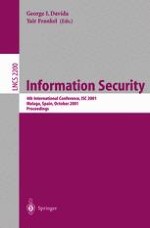2001 | OriginalPaper | Buchkapitel
Privacy Amplification Theorem for Noisy Main Channel
verfasst von : Valeri Korjik, Guillermo Morales-Luna, Vladimir B. Balakirsky
Erschienen in: Information Security
Verlag: Springer Berlin Heidelberg
Enthalten in: Professional Book Archive
Aktivieren Sie unsere intelligente Suche, um passende Fachinhalte oder Patente zu finden.
Wählen Sie Textabschnitte aus um mit Künstlicher Intelligenz passenden Patente zu finden. powered by
Markieren Sie Textabschnitte, um KI-gestützt weitere passende Inhalte zu finden. powered by
Secret key agreement protocol between legal parties based on reconciliation and privacy amplification procedure has been considered in [2]. The so called privacy amplification theorem is used to estimate the amount of Shannon’s information leaking to an illegal party (passive eavesdropper) about the final key.We consider a particular case where one of the legal parties (Alice) sends to another legal party (Bob) a random binary string x through a binary symmetric channel (BSC) with bit error probability εm while an eavesdropper (Eve) receives this string through an independent BSC with bit error probability εw. We assume that εm < εw and hence the main channel is superior to the wire-tap channel. To reconcile the strings between legal parties Alice sends to Bob through noiseless channel the check string y based on some good error correcting code. Since this transmission is completely public Eve can eavesdrop it and therefore this extra information has to be taken into account in an estimation of the information leaking to Eve about the final key. In [3] an inequality has been proved to upper bound the information of Eve in such scenario. The main contribution of the running paper is to improve this inequality and hence to enhance the privacy amplification theorem. We present also bounds for the probability of false reconciliation when the check symbols of the linear code are transmitted through noiseless channel. The presented results can be very useful when considering the non-asymptotic case.
